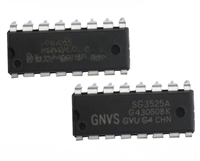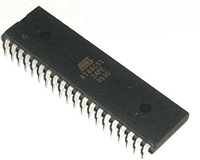CY23020-3
Inserting Other Devices in Feedback Path
Table 2. Frequency Range Setting
RANGE
Output Frequency Range
Due to the fact that the device has an external feedback path
the user has a wide range of control over its output to input
skewing effect. One of these is to be able to synchronize the
outputs of an external clock that is resultant from any of the
output clocks. This implementation can be applied to any
device (ASIC, multiple output clock buffer/driver, etc.) which is
put into the feedback path.
0
1
100–200 MHz
200–400 MHz
Table 3. Frequency Multiplication Table
MUL
Output Frequency
Referring to Figure 1, if the traces between the ASIC/buffer
and the destination of the clock signal(s) (A) are equal in length
to the trace between the buffer and the FBIN pin (B), the
signals at the destination(s) device (C) will be driven high at
the same time the Reference clock provided to the ZDB goes
high. Synchronizing the other outputs of the ZDB to the outputs
from the ASIC/Buffer is more complex however, as any propa-
gation delay in the ASIC/Buffer must be accounted for.
0
1
= REF
= 2 * REF
How to Implement Zero Delay
Typically, ZDBs multiply (fan-out) single-clock signals quantity
while simultaneously reducing or mitigating the time delay
associated with passing the clock through a buffering device.
In many cases the output clock is adjusted, in phase, to occur
later or more often before the device’s input clock to
compensate for a design’s physical delay inadequacies. Most
commonly this is done using a simple PCB trace as a time
delay element. The longer the trace the earlier the output clock
edges occur with respect to the reference input clock edges.
There are constraints when inserting other devices. If the
devices contain PLLs or excessively long delay times they can
easily cause the overall clocking system to become unstable
as the components interact. For these designs it is advisable
to contact Cypress for applications support.
Reference
Signal
C
In this way such effects as undesired transit time of a clock
signal across a PCB can be compensated for.
Zero
Delay
Buffer
ASIC/
Buffer
Feedback
Input
A
B
Figure 1. Output Buffer in Feedback Path
Table 4. Absolute Maximum Ratings[3]
Parameter
Description
Voltage on any VDD pin with respect to GND
Voltage on any input pin with respect to GND
Storage Temperature
Rating
–0.5 to +5.0
–0.5 to VDD + 0.5
–65 to +150
–40 to 85
Unit
V
VDD
VIN
TSTG
TA
V
°C
°C
°C
Operation Temperature (QFN)
TJ
Junction Temperature
135
[4]
Table 5. PECL DC Output Specification
VCC = 3.135
VCC = 3.3
VCC = 3.465
Parameter Description
Conditions
Min.
Max.
Min.
Max.
Min.
Max.
2
2.6
2.165
2.765
VOH
VOL
1.835
2.435
1.3
–1.3
–2
1.135
–1.3
1.735
–0.7
1.9
1.465
–1.3
2.065
–0.7
–0.7
VOH (rel to VCC
)
–2
–1.4
–1.4
–2
–1.4
VOL(rel to VCC
)
These result in the following mid point values:[4]
VMID ((VOH + VOL)/2)
1.485
–1.65
2.085
–1.05
1.65
2.25
1.815
–1.65
2.415
–1.05
–1.65
–1.05
VMID Relative to VCC
Notes:
3. Stresses greater than those listed in this table may cause permanent damage to the device. These represent a stress rating only. Operation of the device at
these or any other conditions above those specified in the operating sections of this specification is not implied. Maximum conditions for extended periods may
affect reliability.
4. The midpoint voltage is average value of a waveform. For differential signals the midpoint is assumed to be the same for both the true and complement since
the VOH and VOL of both the true and complement signals in general should be the same. VMID is not necessarily equal to the differential crossover voltage,
which may be skewed if there is differential time delays between the signals.
Document #: 38-07473 Rev. *A
Page 3 of 9






 SG3525资料手册详解:SG3525参数分析、引脚说明、应用介绍
SG3525资料手册详解:SG3525参数分析、引脚说明、应用介绍

 AT89C51单片机资料手册详细解析及应用示例
AT89C51单片机资料手册详细解析及应用示例

 CP2102资料手册解读:CP2102引脚说明、关键参数分析
CP2102资料手册解读:CP2102引脚说明、关键参数分析

 资料手册解读:UC3842参数和管脚说明
资料手册解读:UC3842参数和管脚说明
